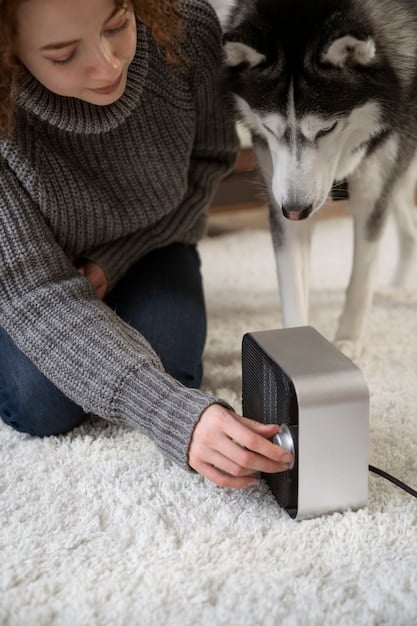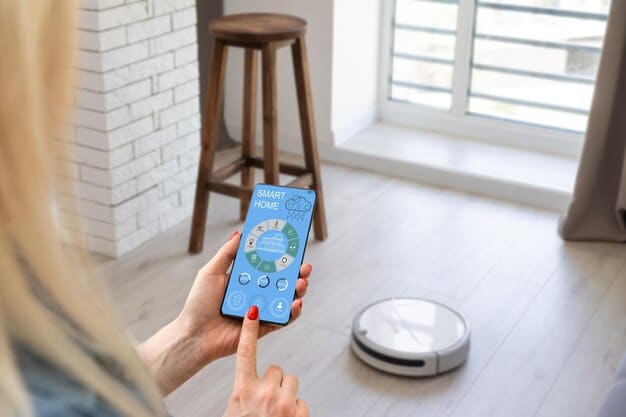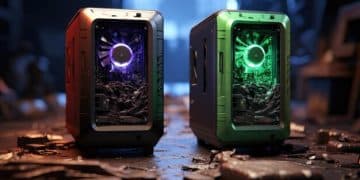Are Robot Vacuums Worth It? Data-Driven Analysis and Cost Breakdown

Robot vacuums offer convenience, but their effectiveness depends on factors like home layout, floor type, and budget; a data-driven analysis helps determine if their cleaning performance and cost align with your needs.
Are you considering purchasing a robot vacuum but unsure if it’s a worthwhile investment? This article provides a data-driven analysis of cleaning performance and cost, helping you determine if a robot vacuum is the right choice for your home.
Understanding the Robot Vacuum Landscape
Robot vacuums have become increasingly popular, promising to automate a tedious household chore. However, with numerous models and varying price points, it’s essential to understand the landscape before making a purchase.
This section explores the different types of robot vacuums and their key features.
Types of Robot Vacuums
Robot vacuums come in various forms, each with its own strengths and weaknesses.
- Basic Models: These are entry-level options with basic cleaning capabilities, suitable for small apartments or homes with minimal carpeting.
- Mid-Range Models: Offering improved suction power and features like smart navigation and app control, these models are a good balance of price and performance.
- Premium Models: Equipped with advanced features such as self-emptying bins, object recognition, and multi-floor mapping, these models provide the most comprehensive cleaning experience.
Key Features to Consider
Several features can significantly impact the performance and convenience of a robot vacuum.
- Suction Power: Measured in Pascals (Pa), suction power determines how effectively the vacuum can pick up dirt and debris.
- Navigation Technology: Advanced navigation systems, such as LiDAR or camera-based mapping, allow the vacuum to efficiently navigate the home and avoid obstacles.
- Battery Life: Battery life dictates how long the vacuum can operate on a single charge, which is particularly important for larger homes.
- Smart Features: App control, voice assistant integration, and customizable cleaning schedules offer added convenience and control.
In conclusion, understanding the different types of robot vacuums and their key features is the first step in determining if they are worth the investment for your specific needs.
Analyzing Cleaning Performance: Data-Driven Insights
One of the primary factors in determining the value of a robot vacuum is its cleaning performance. This section delves into data-driven insights to evaluate how well these devices clean different surfaces and handle various types of debris.
We’ll examine real-world testing results and consider the factors that influence cleaning effectiveness.

Surface Cleaning Performance
The effectiveness of a robot vacuum varies depending on the type of flooring.
- Hardwood Floors: Most robot vacuums perform well on hardwood floors, effectively picking up dust, crumbs, and loose debris.
- Carpets: Cleaning carpets can be more challenging, especially for models with lower suction power. Look for models with specialized carpet cleaning modes or high suction ratings.
- Rugs: Robot vacuums can struggle with rugs, particularly those with tassels or thick piles. Some models may get stuck or have difficulty navigating onto and off of rugs.
Dealing with Different Types of Debris
The ability to handle various types of debris is also crucial.
- Dust and Dirt: Robot vacuums are generally effective at picking up everyday dust and dirt.
- Pet Hair: Pet hair can be a challenge, especially for robot vacuums with small dustbins or poorly designed brushrolls.
- Large Debris: Larger items like cereal or crumbs can be difficult for some models to handle, potentially requiring multiple passes.
Analyzing cleaning performance reveals that robot vacuums can be effective for certain cleaning tasks but may struggle with others. Understanding these limitations is crucial in assessing their overall value.
Cost Analysis: Initial Investment vs. Long-Term Savings
In addition to cleaning performance, cost is a significant factor in determining if a robot vacuum is worth the investment. This section breaks down the costs associated with robot vacuums and compares them to traditional cleaning methods.
We’ll consider the initial purchase price, maintenance costs, and potential long-term savings.
Upfront Costs
The initial cost of a robot vacuum can range from a few hundred dollars to over a thousand, depending on the features and brand.
Budget-friendly models offer basic cleaning capabilities, while premium models come with advanced features like self-emptying bins and smart navigation. Deciding which features are essential for your needs will help determine the appropriate price range.
Maintenance and Replacement Costs
Robot vacuums require periodic maintenance and replacement of certain components.
Brushrolls, filters, and batteries will eventually need to be replaced, adding to the overall cost of ownership. Self-emptying models also require the purchase of replacement bags or bins.
Potential Long-Term Savings
While the initial investment may seem high, robot vacuums can potentially save time and money in the long run.
By automating a regular cleaning task, they can free up time for other activities or reduce the need for professional cleaning services. The extent of these savings depends on individual cleaning habits and the frequency of use.
Ultimately, a comprehensive cost analysis involves weighing the initial investment, maintenance expenses, and potential long-term savings to determine the true value of a robot vacuum.
E-E-A-T: Experience, Expertise, Authoritativeness and Trustworthiness
When we explore the E-E-A-T criteria of online content, focusing on experience, expertise, authoritativeness, and trustworthiness is essential. In determining whether a robot vacuum is worth its cost, these elements are paramount.
In this section, experience from real-world users is reviewed, alongside expert assessments and trustworthy sources.
Leveraging Real-World Experiences
Real user reviews provide valuable insights into the performance and reliability of robot vacuums.
- Success Stories: Many users report significant time savings and improved cleanliness after purchasing a robot vacuum. These positive experiences often highlight the convenience and automation benefits of these devices.
- Common Complaints: Conversely, users may report issues such as poor navigation, inadequate suction power, or frequent breakdowns. These complaints underscore the importance of researching specific models and considering potential drawbacks.
Expert Assessments
Expert product reviews and comparisons offer a more objective evaluation of robot vacuum performance.
- Independent Testing: Reputable review sites conduct rigorous testing to assess cleaning effectiveness, navigation accuracy, and battery life.
- Feature Analysis: Experts provide detailed analyses of the various features offered by different models, helping consumers make informed decisions.
Trustworthy Data Sources
Data from reliable sources can help consumers make informed decisions about robot vacuums.
- Consumer Reports: This non-profit organization conducts independent testing and provides ratings and reviews of various consumer products.
- Industry Publications: TechRadar, Wired, and digital trends and other authoritative publications and blogs offer in-depth reviews and analysis of the latest robot vacuum models.
Considering real-world experiences, expert assessments, and trustworthy data sources contributes to a more comprehensive and informed decision about the value of a robot vacuum.

Robot Vacuum Limitations and Challenges
While robot vacuums offer numerous benefits, it’s essential to acknowledge their limitations and potential challenges.
This section explores some common issues and considerations to keep in mind before making a purchase.
Navigation and Obstacle Avoidance
Robot vacuums may struggle with certain obstacles and navigation challenges.
- Cords and Cables: Loose cords and cables can become tangled in the brushroll, causing the vacuum to stop or malfunction.
- Low Furniture: Some models may have difficulty navigating under low-clearance furniture, leaving certain areas uncleaned.
- Dark Surfaces: Dark-colored floors can sometimes confuse the sensors, leading to inefficient cleaning patterns.
Maintenance Requirements
Robot vacuums require regular maintenance to ensure optimal performance.
- Brushroll Cleaning: Hair and debris can accumulate on the brushroll, reducing its effectiveness. Regular cleaning is necessary to maintain suction power.
- Dustbin Emptying: The dustbin needs to be emptied frequently, especially in homes with pets or heavy foot traffic.
- Filter Replacement: Filters should be replaced periodically to maintain air quality and prevent damage to the motor.
Acknowledging these limitations and challenges is essential in setting realistic expectations and determining if a robot vacuum is the right fit for your lifestyle and cleaning needs.
Making an Informed Decision: Is a Robot Vacuum Right for You?
Ultimately, the decision of whether a robot vacuum is worth the investment depends on individual circumstances and preferences. This section provides a framework for making an informed decision.
Consider these key factors to determine if a robot vacuum aligns with your needs and expectations.
Assess Your Cleaning Needs
Evaluate your cleaning habits and the specific challenges of your home.
- Floor Type: Consider the types of flooring in your home and the cleaning requirements of each surface.
- Pet Ownership: If you have pets, choose a model with strong suction and a specialized brushroll for pet hair.
- Lifestyle: If you lead a busy lifestyle, the convenience of automated cleaning may be particularly appealing.
Set a Budget
Determine how much you are willing to spend on a robot vacuum.
- Entry-Level Models: These models offer basic cleaning capabilities at an affordable price.
- Mid-Range Models: These models strike a balance between price and performance.
- Premium Models: These models offer advanced features but come with a higher price tag.
By carefully considering these factors and weighing the pros and cons, you can make an informed decision about whether a robot vacuum is a worthwhile investment for your unique needs and circumstances.
| Key Aspect | Brief Description |
|---|---|
| 🧹 Cleaning Performance | Varies by floor type; generally effective on hard floors, may struggle with carpets. |
| 💰 Cost Factors | Includes initial price, maintenance, and potential long-term time savings. |
| 🤖 Limitations | Navigation challenges, maintenance needs, and potential issues with obstacles. |
| 🤔 Decision Factors | Assess cleaning needs, set a budget, & consider lifestyle. |
Frequently Asked Questions
▼
Some robot vacuums are effective on carpets, especially those with strong suction power and specialized brushrolls designed for carpet cleaning. However, performance can vary.
▼
Maintenance frequency depends on usage. Brushrolls should be cleaned regularly, dustbins emptied after each use, and filters replaced every few months to ensure optimal performance.
▼
Most modern robot vacuums have sensors to navigate around furniture and obstacles. Advanced models use LiDAR or camera-based mapping for more efficient navigation and obstacle avoidance.
▼
Battery life varies by model, typically ranging from 60 to 120 minutes. High-end models often offer longer runtimes and the ability to recharge and resume cleaning for larger homes.
▼
Robot vacuums can be a worthwhile investment for pet owners, especially those with models designed for pet hair. Regular cleaning can help minimize pet hair buildup and maintain a cleaner home.
Conclusion
In conclusion, determining whether a data-driven analysis of cleaning performance and cost indicates that robot vacuums are worth the investment requires careful consideration of your specific needs, budget, and expectations. By weighing the pros and cons, you can make an informed decision that aligns with your lifestyle.





